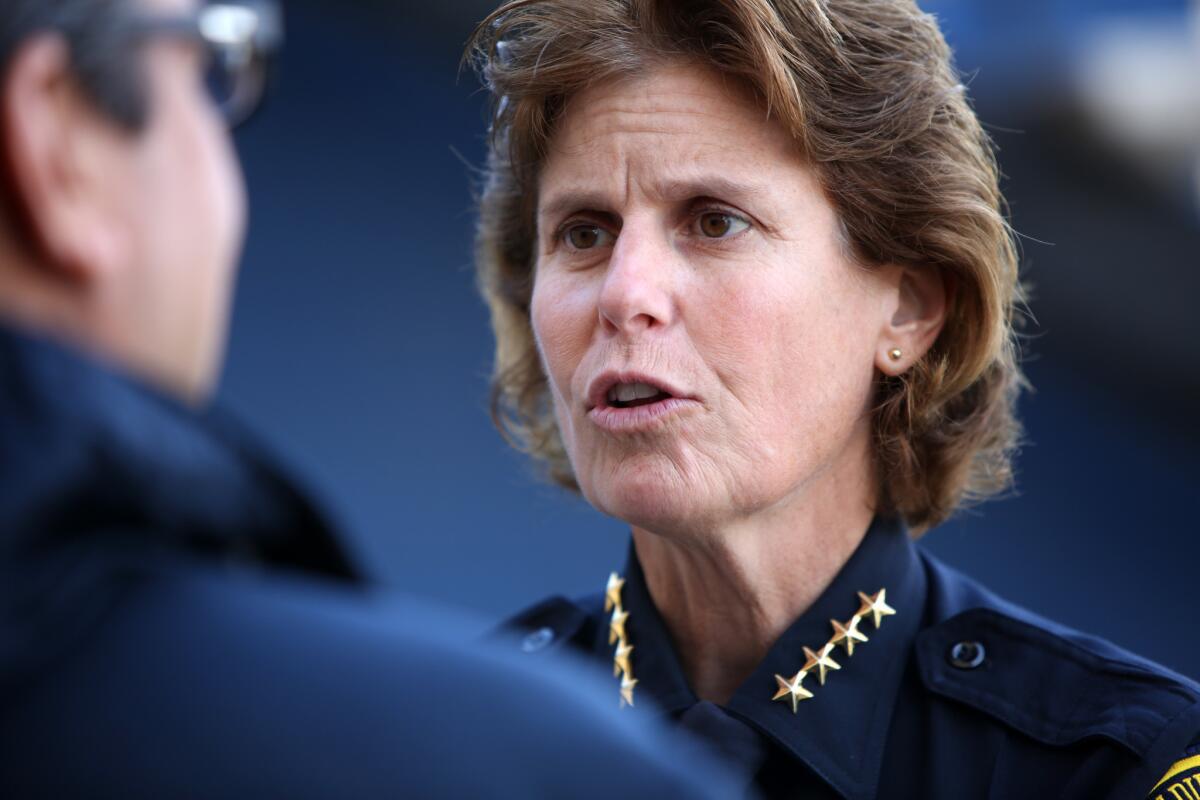San Diego police tighten body camera rules after fatal shooting

San Diego Police Chief Shelley Zimmerman has tightened rules involving body cameras after a fatal shooting in which the officer who opened fire did not switch on his camera.
- Share via
The San Diego Police Department has tightened its requirements for officers wearing body cameras after the fatal shooting of a man by an officer who had not switched on his camera.
The shooting is being investigated by the homicide unit, whose report will be reviewed by the district attorney’s office, the standard procedure in officer-involved shootings.
On Thursday, Police Chief Shelley Zimmerman announced that she had revised the body camera policy so that “officers will now be trained to start recording prior to their arrival on radio calls that are likely to result in an enforcement contact.”
Department policy previously required officers to turn on the small cameras when an enforcement action was imminent.
The change comes after the fatal shooting of 42-year-old Fridoon Zalbeg Rawshannehad shortly after midnight on April 30 in an alley behind an adult bookstore in the city’s Midway neighborhood.
Officer Neal B. Browder, a 27-year veteran of the department, responded to a call that a man with a knife was threatening people inside and outside the bookstore.
Browder confronted Rawshannehad in the alley and gave him “verbal commands ... but he continued to advance on the officer,” according to Lt. Mike Hastings.
Browder fired at least once. Afterward, a knife sheath and a metallic object, but no knife, were found near the body, Hastings said.
The incident was recorded on a surveillance camera outside the store. But Browder had not turned on his body camera for reasons that have not been explained publicly.
The American Civil Liberties Union has been critical of Browder’s failure to turn on his camera and also of the Police Department’s refusal to release the tape from the surveillance camera.
“Where’s the transparency? Where’s the accountability?” said Margaret Dooley-Sammuli, criminal justice and drug policy director for the ACLU of California.
“The department has said it is deploying body cameras in part to build community trust,” she said. “Releasing the surveillance video would show the community the department is committed to that promise.”
Zimmerman, as well as Mayor Kevin Faulconer, are supporters of the use of body cameras by police officers and have taken pride in the fact that the San Diego department is among the largest in the nation to require the cameras.
An initial report for the City Council showed that use of the body cameras led to a decline in both complaints against officers and instances of officers using force.
Some 600 San Diego officers are outfitted with the cameras. Zimmerman plans for several hundred more officers to have them by year’s end.
Hastings declined to comment on media reports that Rawshannehad was homeless and living on the street near the alley outside the Highlight Book Store.
“A policy means nothing if officers are not accountable to it,” said the ACLU’s Dooley-Sammuli.
For more San Diego area news, follow @LATsandiego on Twitter.
More to Read
Sign up for Essential California
The most important California stories and recommendations in your inbox every morning.
You may occasionally receive promotional content from the Los Angeles Times.













